Flensburg
![]()
This article is about the German city of Flensburg, for other meanings see Flensburg (disambiguation) and Flensborg (disambiguation).
Flensburg (Danish and Low German: Flensborg, North Frisian: Flansborj, Flensborag, South Jutlandic: Flensborre) is a large district-free medium-sized city in the north of Schleswig-Holstein. After Kiel and Lübeck, Flensburg is the third largest city in the state with over 90,000 inhabitants, the largest in the Schleswig district, and the northernmost county-free city in Germany.
As the centre of the Danish minority in southern Schleswig, Flensburg took a pioneering role in the recognition of national minorities after the referendum in Schleswig in 1920 and the Bonn-Copenhagen Declarations of 1955, covered by a large number of Danish institutions. From a not small part of the according to own information about 96,920 inhabitants (as of December 2019) are spoken besides German and Danish still Plattdeutsch and Petuh.
The port city gained nationwide fame through the "points in Flensburg" stored by the Federal Motor Transport Authority, the Beate Uhse mail-order erotic shop, Flensburg beer and the SG Flensburg-Handewitt handball club, internationally through the seat of the last Reich government in 1945 under the leadership of Karl Dönitz in the Mürwik district. Factors such as the rum trade and military facilities, such as the naval base at Flensburg-Mürwik, which shaped the city's growth in the 19th and 20th centuries, now play only a minor role. Of greater importance for the upper center are the pronounced border tourism, the Flensburg port with the historic port and the shipyard of the FSG and with about 9200 students (winter semester 2014/2015) the university and European University Flensburg.
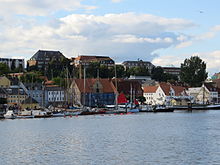
Buildings in the style of heritage architecture or Bedre Byggeskik, here on Marienberg, characterize the upper silhouette on the west bank. Below, the museum harbour and the Kompagnietor at the ship's bridge (2013).

In the city centre, the Hafenspitze, a central place of regular events in Flensburg, marks the beginning of the Flensburg Fjord. In the background, St. Jürgen Church, the Volkspark with the Mürwiker Water Tower, Werftkontor and the silos of Flensburg's industrial port (from right to left, 2011).
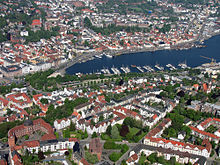
Aerial view with the city centre and Flensburg harbour
Geography
Geographical position
The municipal area of the city of Flensburg is located at the inner end of the Flensburg Fjord in the northwest of the Angeln peninsula on the German-Danish border in the Schleswig-Holstein Hills nature area. The nearest border crossing to Denmark is in the neighbouring municipality of Harrislee in the district of Schleswig-Flensburg to the north. After the neighbouring town of Glücksburg, Flensburg is the second northernmost town in the Federal Republic of Germany. The city area stretches along the western and southern shores of the Flensburg Fjord over various hills such as the Frisian Mountain or the Marienberg. The eastern shore area of the city is already counted to the peninsula Angeln. The highest point in the city area with at least 64 m above sea level is located in the area of the Marienhölzung near the Duburg junction of the federal highway 200. The inner city area is located at the ZOB at a height of only 3 m above sea level.
Districts
The city of Flensburg is divided into 13 districts, which in turn are subdivided into a total of 38 statistical districts. The boundaries of today's districts and boroughs only approximately follow the historical boundaries of the former rural parishes or the historical parish boundaries of the old Stadtfeld. The districts of Flensburg are Altstadt (or Flensburg city centre), Engelsby, Friesischer Berg, Fruerlund, Jürgensby, Mürwik, Neustadt, Nordstadt, Sandberg, Südstadt, Tarup, Weiche and Westliche Höhe.
Overview: City districts, city boroughs and other districts
| No. | District | Location | Inhabitants | Migrants | Boroughs | Other districts | Collection of images |
| 1 | Old town (city centre) | Lage54.7861111111119.4336111111111 | 3.324 | 801 (24,1 %) | St. Nikolai (Saint Nikolaj) |
Commons: City centre | |
| 2 | New Town | Lage54.79759.4261111111111 | 4.134 | 1138 (27,5 %) | Duburg (Duborg) |
Commons: Neustadt | |
| 3 | North City | Lage54.8005555555569.4211111111111 | 10.994 | 3312 (30,1 %) | (Harrisleer) Cross (Kors) | Baltic Sea resort (Østersøbadet) |
Commons: Nordstadt |
| 4 | Western Heights | Lage54.7880555555569.4277777777778 | 7.897 | 1427 (18,1 %) | City Park (Byparken/Øvelgønne) | FalkenbergMarienhof |
Commons: Western Heights |
| 5 | Frisian Mountain | Lage54.7802777777789.4236111111111 | 6.686 | 1293 (19,3 %) | Exe (Eksercerløkke) | Gottrupel section on the town pathHarrisleehof section |
Commons: Frisian mountain |
| 6 | Soft | Lage54.7552777777789.4022222222222 | 6.939 | 1399 (20,2 %) | Sophienhof (Sophiegård) |
Commons: Switch | |
| 7 | South City | Location54.7759.435 | 4.034 | 813 (20,2 %) | Martinsberg (Martinsbjerg) |
Commons: Südstadt | |
| 8 | Sandberg | Lage54.7816666666679.4533333333333 | 6.012 | 872 (14,5 %) | Achter de Möhl (Fiskergården) | western part of Löwenberg |
Commons: Sandberg |
| 9 | Jørgensby | Lage54.7894444444449.4561111111111 | 7.850 | 1159 (14,8 %) | Johannesviertel (Saint Hans) | FruerlundmühleHulvejene (Hulve Mill) |
Commons: Jürgensby |
| 10 | Fruerlund | Lage54.8030555555569.4588888888889 | 6.333 | 1067 (16,8 %) | Blasberg (Blæsbjerg) | Kielseng (Kilseng) |
Commons: Fruerlund |
| 11 | Mürwik | Lage54.8108333333339.4613888888889 | 14.334 | 2454 (17,1 %) | Flensburg-Mürwik baseOsbek (Osbæk) | Blocksberg (Bloksbjerg) |
Commons: Mürwik |
| 12 | Engelsby | Lage54.7913888888899.4769444444444 | 7.774 | 1843 (23,7 %) | Engelsby South (Engelsby syd) | Musicians' quarterWindhole (Vejrgab) |
Commons: Engelsby |
| 13 | Tarup | Lage54.7813888888899.4763888888889 | 4.317 | 689 (16,0 %) | Tarup | Adelby Eastern |
Commons: Tarup |
Neighboring communities
The following municipalities of the district of Schleswig-Flensburg and the region of Syddanmark border the city of Flensburg - clockwise starting in the northeast: Glücksburg (independent municipality), Wees (independent municipality), Maasbüll, Hürup, Tastrup and Freienwill (all independent municipality), Handewitt (independent municipality), Harrislee (independent municipality) and the municipality of Aabenraa (Apenrade) on the Danish side of the Flensburg Fjord.
Harrislee with the associated districts Wassersleben and Kupfermühle, as well as Wees and Tastrup are considered suburbs of Flensburg. They are structurally more or less densely intergrown with the city. The municipality of Harrislee in particular has insisted on its independence since the 1970s - despite repeated proposals by the city of Flensburg to incorporate it.
Tastrup, in turn, is a remnant of the former municipality of Adelby, which was gradually incorporated. Due to the steady expansion of the district of Sünderup, Flensburg is growing ever closer to Tastrup. The situation is similar in Wees, where new housing estates are being developed in the Flensburg districts of Wasserloos and Kauslund, which are located on the Nordstraße (federal highway 199). Another settlement that has grown seamlessly with Flensburg for many years is Meierwik, which nevertheless belongs to the town of Glücksburg. Handewitt, which borders on the Schäferhaus airfield and is not far from the Flensburg district of Weiche, has also grown quite close to Flensburg. The togetherness is strengthened by the Flensburg-Handewitt playing association, which has existed since 1990. Furthermore, Maasbüll is sometimes considered to be a rural suburb of Flensburg, although the village is not closely related to Flensburg. Maasbüll, which is characterised by local recreation and agriculture, lies close to the Vogelsang area, which is hardly built on.
Neighboring cities
Distances to neighbouring cities
Nearby large cities are Schleswig-Holstein's state capital Kiel (247,000 inhabitants) and in Denmark Odense (170,300 inhabitants) and Aarhus (256,000 inhabitants); the nearest megacity is Hamburg (1.8 million inhabitants), about 141 km away in the south. Arnis, the smallest town in Germany by population (300 inhabitants) and area (0.45 km²), is about 36 km from Flensburg.
The distances are as the crow flies between Flensburg and the respective city.
| Esbjerg (99 km) | Aarhus (161 km) | Odense (91 km) |
| Süderlügum (40 km)Leck (30 km) |
| |
| Husum (41 km) | Schleswig (30 km) | Kappeln (35 km) |
Climate
Monthly averages
| Monthly mean values of Flensburg 1961-1990
Source: DWD: Klimadaten Deutschland, Mittelwerte 30-jähriger Perioden, DWD: Klimadaten Deutschland, Mittelwerte 30-jähriger Perioden 1981-2010 für die Sonnenstunden sowie weatherbase: Flensburg, Germany | |||||||||||||||||||||||||||||||||||||||||||||||||||||||||||||||||||||||||||||||||||||||||||||||||||||||||||||||||||||||||||||||||||||||||||||||||||||||||||||||||||||||||||||||||||||||||||||||||||||||||||||||||||||||||||||||||||||||||||||
,_Bild_00.jpg)
Winter in Flensburg: View of the harbour, the fjord and the district Jürgensby. In the foreground the tugboat Solitüde from 1943 and the fishing cutter Jægerpris from 1960 (January 2013).

Location of Flensburg on the Flensburg Fjord with districts and neighbouring communities (clickable graphic)
History
Pre- and protohistoric human traces
Various traces of human life and activity from the time of prehistory and early history have been discovered in the town area. Sites that bear witness to these times include the Friedenshügel, Nonnenberg and Weinberg burial mounds.
Origin of the name
The origin of the city name Flensburg, which was first mentioned in 1248, has not yet been clarified. According to a legend, Duke Knud Lavard gave a knight Fleno the order to build a castle at the end of the fjord. This Fleno castle is said to have given the town its name. A more recent theory is that the name derives from a small tower fortress whose foundations were found near St. Mary's Church and which was located on something like a small island, peninsula or headland.
In addition to the founding myth about the knight Fleno, Flensburg has an apocalyptic myth about its downfall, the starting point of which is said to be at the Hafermarkt and in which the Black Pig plays a decisive role.
Beginnings of Flensburg
At the latest in the middle of the 12th century, a trading and fishing settlement developed around Sankt Johannis in the inner area of the Flensburg Fjord. Due to its location, the St. Johannis settlement belonged to the Husbyharde in Angeln. In 1170, the parish of Sankt Marien was established as an extension of the western shore of the fjord, followed by Sankt Nikolai around 1200 and finally Sankt Gertrud in 1290. This side belonged to the Wiesharde and lay in the catchment area of the brook Scherrebek. Both areas were part of the Kingdom of Denmark at that time. Historians assume that there were several reasons for the choice of settlement at this site. After the overcoming of the Wendish land and sea domination as a result of the reconciliation of the Danish King Waldemar I with Henry the Lion, life directly on the water had become safer. The place was considered a safe harbour on the fjord with protection from fierce winds. Two important trade routes of the time crossed at this place. These were the historically important Ox Road, which ran through the whole of Jutland, and the trade route between North Friesland and Angeln (one of the fishing boulevards). The large supply of herring in the fjord was also an important factor for economic well-being.
In the course of time, the small trading settlements gained in importance and grew more and more together. At this time, the Knudsgilde already existed, a determining power in Flensburg, which consisted of wealthy merchants and was already equipped with privileges at that time. It was able to exert influence on the city government. After battles between the Danish king Erik Plovpenning and his brother and successor Abel, the town centre that had been sprouting up in the Dammhof area was destroyed in 1248. Abel promoted the rebuilding of the village. Probably in 1263 or earlier the Minorite monastery was built. In 1284, the Danish King Erik Glipping granted the new town a town charter, the contents of which indicate very lively trade. Duke Waldemar IV of Schleswig confirmed the town charter. Flensburg quickly became the most important town of the Duchy of Schleswig, a Danish fief with the Danish king as feudal lord, which, in contrast to the neighbouring Holstein to the south, did not belong to the Holy Roman Empire. Like other towns in Schleswig, Flensburg was not a member of the Hanseatic League. Nevertheless, there were close trade contacts with German and European Hanseatic cities. An important commodity at that time were herrings pickled in salt, which were shipped throughout Europe.
The trading city in the Middle Ages and early modern times
From 1409 onwards, the disputes between the Holsteiners and the Danes for supremacy in Schleswig began (see also Sønderjylland). In 1411, Queen Margarethe I achieved the cession of large parts of the Duchy of Schleswig to Denmark in the Treaty of Kolding. In the same year, Duburg Castle was built on Marienberg.
On 28 October 1412, Margarethe I died of the plague on board a ship in the port of Flensburg. The plague and other infectious diseases were a major problem for medieval cities. At certain intervals, smallpox, bubonic plague caused by the rat flea (Xenopsylla cheopis), red dysentery or other epidemics ravaged large parts of Flensburg's population. Lepers were isolated in the St.-Jürgen-Hospital (built before 1290), which was located in front of the city gates (today: St.-Jürgen-Kirche). Around 1500 syphilis was introduced. The ecclesiastical hospital Zum Heiligen Geist (today: Heiliggeistkirche) is located in the Große Straße (today Flensburg pedestrian zone).
The everyday life of the people of Flensburg was hard, the traffic routes were bad. The main roads were not paved and unlit. Partly the citizens were obliged to make the paths, which were soaked with cattle dung, passable with wooden footbridges. Only a few patrician houses had windows. Every burgher household kept livestock in the house and yard. Citizens also had their own cowherds and swineherds who herded the cattle outside the city during the day.
During Denmark's war against the Hanseatic League and Holstein, Danish mercenaries conquered and plundered the city in 1426, followed by Holstein and Hanseatic mercenaries in 1431. In 1485 there was a great fire in Flensburg. The city was also not spared from storm tides. The water levels of earlier storm tides can still be read today at the Kompagnietor.
The Lutheran doctrine took root in Flensburg from 1526. At that time, the Husum reformer Hermann Tast preached in the city. Supported by the young Duke Christian, the former Dominican Gerd Slewert pushed the Reformation forward. On April 8, 1529, the Flensburg Disputation took place, a religious discussion that took place in Flensburg's St. Katharinenkloster between Melchior Hofmann and representatives of the Lutheran clergy. As a result of the disputation, the Lutheran Reformation was introduced in Denmark and the duchies of Schleswig and Holstein.
After the decline of the Hanseatic League in the 16th century, Flensburg was considered one of the most important trading cities in the Scandinavian region. The trade relations of the Flensburg merchants even reached as far as the Mediterranean, Greenland and the Caribbean. Apart from herrings, the most important goods traded were sugar and fish oil, which was obtained by whaling on the so-called Greenland voyage. It was not until the Thirty Years' War that the heyday came to an end. The invasion of the imperial forces under Wallenstein in 1627 and 1628 as well as the Danish-Swedish Wars of 1643-1645 and 1657-1660 inflicted considerable wounds on the prosperity of the town.
Revival as a city of rum in the 18th/19th century
In the 18th century, Flensburg experienced a second heyday thanks to the rum trade. The cane sugar was imported from the Danish West Indies and refined in Flensburg, presumably as part of the triangular trade. In the 19th century, in the course of industrialisation, Flensburg's sugar refineries could no longer hold their own against competition from the neighbouring metropolises of Copenhagen and Hamburg.
The rum blended in Flensburg was a fallback business in the West Indies trade, from where it was imported and distributed throughout Europe as a rum blend. After the German-Danish War, rum was sourced from the then British Jamaica instead of the Danish West Indies from 1864 onwards. Rum was never distilled in Flensburg, but only processed. Of once far more than 20 rum houses (among others Hansen, Pott, Sonnberg, Asmussen and Detleffsen), which have shaped the city, the rum house A. H. Johannsen in the Marienstraße still exists today.
The city also began to grow beyond the city walls in the 18th century. The district Neustadt was created and with the Hafermarkt (harbour market) also a wide market place near St. Johannis. Between 1460 and 1864, Flensburg was the second largest port in the Danish state after Copenhagen and even the largest outside the Kingdom of Denmark. In 1848, the Battle of Bau led to fighting in Flensburg's New Town. After the German-Danish War (1864), the city became part of Prussia, and the High German language, which had already gained a foothold in Flensburg's bourgeoisie since the Reformation, increasingly shaped the life of the city. Nevertheless, a considerable minority of the people of Flensburg still count themselves as part of the Danish ethnic group.
The doctor Peter Henningsen founded the Ostseebadgesellschaft together with merchants in 1875 and tried to establish an open-air bath with spa operations on the Flensburg Fjord. The lido Ostseebad remained from the plans.
On 1 April 1889 Flensburg formed an independent urban district (kreisfreie Stadt) within the province of Schleswig-Holstein, but remained the seat of the administrative district of Flensburg.
Referendum in Schleswig
→ Main article: Referendum in Schleswig
In 1920, following a decision by the League of Nations, a vote was held on the course of the border in Schleswig (Southern Jutland). In Northern Schleswig, the vote was held en bloc. There, 75% of the entire population voted for Denmark, whereas the numerically inferior population of the southern towns in this area voted for Germany and were thus outvoted by the northern rural population. Thus the towns of Tondern (with 76% votes for Germany), Hoyer (with 73% votes for Germany), Tingleff (with 64% votes for Germany), the more easterly situated Sonderburg (with 55% votes for Germany) and the already somewhat more northerly situated Apenrade (with 54% votes for Germany) as well as the southern areas of the voting area, in which approximately 40-59%, in some cases even more of the respondents voted for Germany, went to Denmark. Southern Schleswig, including Flensburg, voted by a large majority to remain with Germany. The Danish side's hope of winning over one or two municipalities due to the smaller size of this area was thus not fulfilled. Only in three municipalities of the islands of Sylt and Föhr, which otherwise had a majority in favor of Germany, did a weak Danish majority result. As a result of the cuts of the voting zones and voting modalities defined in the Treaty of Versailles, large parts of the surrounding area, in particular the district of Flensburg, the Kollunder Forest thus fell to Denmark; Flensburg became a border town.
The city of Flensburg received the German House from the German Imperial Government in gratitude for the pro-German vote. Borgerforeningen and Flensborghus developed into centres of the Danish Flensburgers.
National Socialism and the Second World War
When the National Socialists came to power in 1933, the city administration in Flensburg was also brought into line and Wilhelm Sievers, a long-time member of the NSDAP, was appointed mayor. After an intrigue within the party, he was replaced at the end of 1935 by Ernst Kracht, who had the Bismarck Fountain removed in 1937 for ideological reasons. During the National Socialist era, people with a Jewish background were persecuted. On November 9, 1938, the Jägerslust farm was raided by the police and SS, after which almost the entire Jewish Wolff family who lived there was transferred to a concentration camp and murdered there (see Jägerslust farm). Today 23 Stolpersteine in Flensburg bear witness to these persecutions. In the course of rearmament, Flensburg's importance as a naval base and army garrison grew. In 1938, the customs school Flensburg was also established in the old Oberrealschule and Agricultural School, the predecessor of the Goethe School.
During the Second World War, the city nevertheless suffered only selective war damage from 41 bombing raids, which claimed a total of 176 lives and destroyed 4.7% of the city. On 19 May 1943, 15 children and 2 employees of a Danish kindergarten died when the air-raid shelter on Batteriestraße, close to the shipyard and power station, received a direct hit. About 1000 flats were completely destroyed by the 41 air raids on Flensburg. From 1943 onwards, a number of resistance groups formed in the city, to which the tenant of the Borgerforeningen, Hanni Matthiesen, belonged. In 1944, the Frøslev internment camp was established, which was not very far behind the border. On 30 November 1944 Jens Jessen, who grew up in Flensburg, was executed in Berlin-Plötzensee as part of the resistance.
Shortly after the war, on 14 June 1945, an explosion accident at an ammunition depot in Kielseng in Flensburg claimed numerous victims. 60 people died immediately from the explosion, in total there were 88 dead and at least 200 injured.
End of war
→ Main article: Dönitz government and special area Mürwik
After Adolf Hitler's suicide on 30 April 1945 and the conquest of Berlin in the same year, Mürwik was the seat of the last Reich government under the leadership of Grand Admiral Karl Dönitz for a few weeks in May 1945. His staff took up quarters in the military area of the aforementioned Flensburg district. At the same time, quite a number of important Nazi functionaries came to Flensburg via the so-called Rat Line North - with the aim of taking part in the government or escaping prosecution by the Allies and going into hiding. On this way especially thousands of incriminated doctors, officers and NSDAP functionaries were provided with new papers. Very useful for this was the still functioning bureaucracy of the last Reich government, which managed to turn many high-ranking Nazi criminals into simple Wehrmacht soldiers. They received their papers and uniforms at the Mürwik Naval School.
Many of these fugitives were captured by the British on their way south and, on the basis of their (new) papers, released after a few months as "simple Wehrmacht soldiers", among them the "Marinemaat Franz Lang", in reality Rudolf Höß, the camp commander of the Auschwitz-Birkenau death camp. The latter was only arrested by British troops on March 11, 1946, after he had hidden under a false name on the Hansen farm in Gottrupel. Other criminals, rescuing themselves unmolested through the occupation period, later found themselves in high offices in what later became the Federal Republic of Germany, including high positions in medicine, politics or the economy of the Federal Republic of Germany. This gave the city of Flensburg a central and far-reaching role in the last days of the war and beyond.
The provisional government was located on the outskirts of the Mürwik Naval School in the Naval Sports School. There its members were deposed and arrested by British troops on 23 May 1945.
Postwar
After the end of the Second World War, Flensburg belonged to the British occupation zone. The British military administration set up two DP camps in Flensburg to house so-called displaced persons. The majority of them were former forced labourers from Poland, Ukraine, the Baltic States and Yugoslavia.
In the period after the war, many displaced persons arrived in the city, so that the population exceeded 100,000 and Flensburg was a large city for a few years. During this time, the DRK Tracing Service was founded in Flensburg. As in the rest of Schleswig, a relatively strong pro-Danish movement developed in Flensburg after 1945, based on the ideas of the Eider Danes. The goal of many followers was the annexation of the city to Denmark. Flensburg thus had mayors from the Danish minority for several years after 1945 (cf. Flensburg Social Democratic Party).
In 1956, the Flensburg Customs School, which had last been located in the Mürwik Naval School, was moved out of Flensburg. The inner-German border had gained in importance. The Cold War had begun and the Navy needed the building on the Fjord again and moved into it in the same year.
After the founding of the Federal Republic of Germany, Flensburg increasingly benefited from the settlement of military facilities, which were intended to compensate for the economic disadvantages of the city's peripheral location. The decision to locate the Federal Motor Transport Authority in Flensburg was also part of the context of structural promotion. However, since German reunification in 1990, the number of soldiers decreased again by more than 8000, as military facilities were dismantled or relocated to the eastern states. In particular, the larger floating units were relocated to Mecklenburg-Western Pomerania along with the land-based supply facilities. This eliminated the time-consuming march of the fleet units through the Flensburg Fjord to their areas of operations in the Baltic Sea. Today, the former harbour facilities of the German Navy are used by pleasure boats for civilian purposes (Marina Sonwik). The withdrawal of so many soldiers after 1990 contributed significantly to Flensburg falling into an economic crisis and being plagued by high unemployment.
German-Danish border trade still plays a major role today. Some Danish companies such as Danfoss settled directly south of the border in Flensburg and its neighbouring communities for tax reasons.
In 1970, the district of Flensburg-Land was expanded to include the municipalities of the Medelby district in the Südtondern district and in 1974 was merged with the district of Schleswig to form the new district of Schleswig-Flensburg, whose district seat became the city of Schleswig. Flensburg thus lost its function as a district town, but remained a district-free town itself.
During the snow disaster in northern Germany at the end of 1978, Flensburg was cut off from the outside world. Even recovery tanks of the Bundeswehr were not able to clear the Autobahn 7 and the train traffic to Kiel was paralyzed. The catastrophe was accompanied by high water. With a water level of up to 1.60 m above sea level, roads near the port were flooded.
21st century
From 2004 to 2008, a project of the Flensburger Baukultur association attracted nationwide attention, in which Flensburg city thinkers looked at the city from an unbiased perspective and contributed new ideas to urban planning development.
In April 2010, the Hells Angels MC Chapter Flensburg, a chapter of the Hells Angels Deutschland, made national headlines when the then Minister of the Interior Klaus Schlie (CDU) banned both the Flensburg Hells Angels and the Neumünster Bandidos for allegedly "blackmailing innkeepers for protection money, attacking an enemy Bandido on a motorway and hoarding weapons". The Higher Administrative Court of Schleswig confirmed the ban in June 2012. Despite the ban, the rockers remained active. Therefore, two years later in June 2014, the Flensburg public prosecutor's office and the Schleswig-Holstein State Criminal Police Office initiated a large-scale raid in which 13 apartments in Flensburg and the surrounding area, the club's home in Batteriestraße (with the sign Red Devils, later Red and White) and a pub at the Schiffbrücke were searched.
Today, Flensburg is the largest city in the Schleswig district and the centre of the German-Danish borderland. The city is the seat of a university and university of applied sciences and is still characterized by the navy, border trade and its history as a rum town. Due to the poor financial situation of the city, the council decided in 2006 to sell the Kollunder Forest to a private person.
Incorporations
The first incorporation, the incorporation of the Rude, is known from 1398. At the end and beginning of the 19th century, large parts of the Ostufer were incorporated, which considerably increased Flensburg's area. In the 1970s, the communities near Adelby, except Tastrup, were incorporated.
Until the middle of the 19th century, the urban area of Flensburg covered a total area of 2639 hectares. In the course of time, the following municipalities or parishes were incorporated into the city of Flensburg:
| Year | Locations | Change in ha |
| 1398 | Rude | |
| March 3, 1874 | Süder- and Norder-St. Jürgen | 36,58 |
| 1874 | Fishermen's Farm | 3,58 |
| July 27, 1875 | Duburg | 10,5,58 |
| 1877 | Hollowways | 5,5,58 |
| 01 December 1900 | Jürgensgaard (most of the district of Jürgensby) | 205,58 |
| 01 April 1909 | Klues | 19,58 |
| 01 April 1910 | Engelsby, Fruerlund, Twedt and Twedterholz | 1458,58 |
| April 26, 1916 | Part of the Kluesrieser Forest (incl. water area) | 146,58 |
| April 26, 1970 | Adelbylund (Municipality of Adelby) | 132,58 |
| 01 November 1971 | Municipalization of the beach of Wassersleben | 147,58 |
| 1972 | Adjustment of the border between Flensburg and Harrislee, largely to the course of the west tangent road | |
| March 24, 1974 | Sünderup and Tarup (Adelby parish) | 494,58 |
| 1975 | a part of Meierwik of the municipality of Glücksburg | |
| 2007 | Takeover of an area east of Kattloch near Tarup from the municipality of Tastrup |
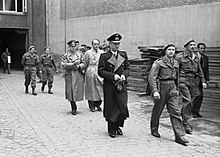
May 1945 in the courtyard of the police headquarters at Norderhofenden: In the presence of the world press, Karl Dönitz (center, in admiral's uniform) was brought before the court, behind him Alfred Jodl and Albert Speer.
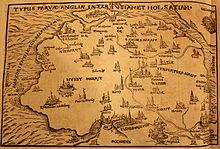
Flensburg and Angeln in the year 1596.

Ship bridge around 1833
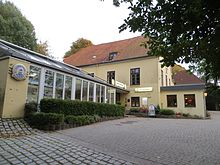
The home of the Knudsgilde, founded in the 12th century, has been St. Knudsborg at Hillig-Water Gang (Helligvandsgangen) since 1844.
.JPG)
The town charter of Flensburg from the year 1284
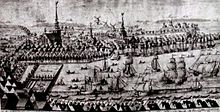
Flensburg harbour around 1783

View of Flensburg (around 1830)
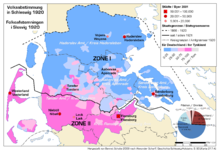
In the 1920 referendum in Schleswig, three quarters of the voters in Flensburg voted to remain part of the German Reich. As a result, Flensburg became a border town.

Where ships such as those of the 1st Minesweeper Squadron, the 3rd Fast Boat Squadron and the Fleet Service Squadron were once stationed at the Mürwik naval base, water houses and a marina now adorn the new Sonwik district. (2015)
Questions and Answers
Q: What is Flensburg?
A: Flensburg is a city in Germany.
Q: What is the population of Flensburg?
A: About 90,164 people live in Flensburg.
Q: Where is Flensburg located?
A: Flensburg is located next to the border with Denmark.
Q: Does Flensburg have a university?
A: Yes, Flensburg has a university.
Q: What is Mürwik?
A: Mürwik is a well-known part of Flensburg.
Q: What can be found in Mürwik?
A: In Mürwik, there lies a small navy harbour.
Q: What supports the economy of Flensburg?
A: Flensburg's economy is supported by tourism, students, and the German navy forces.
Search within the encyclopedia
.svg.png)